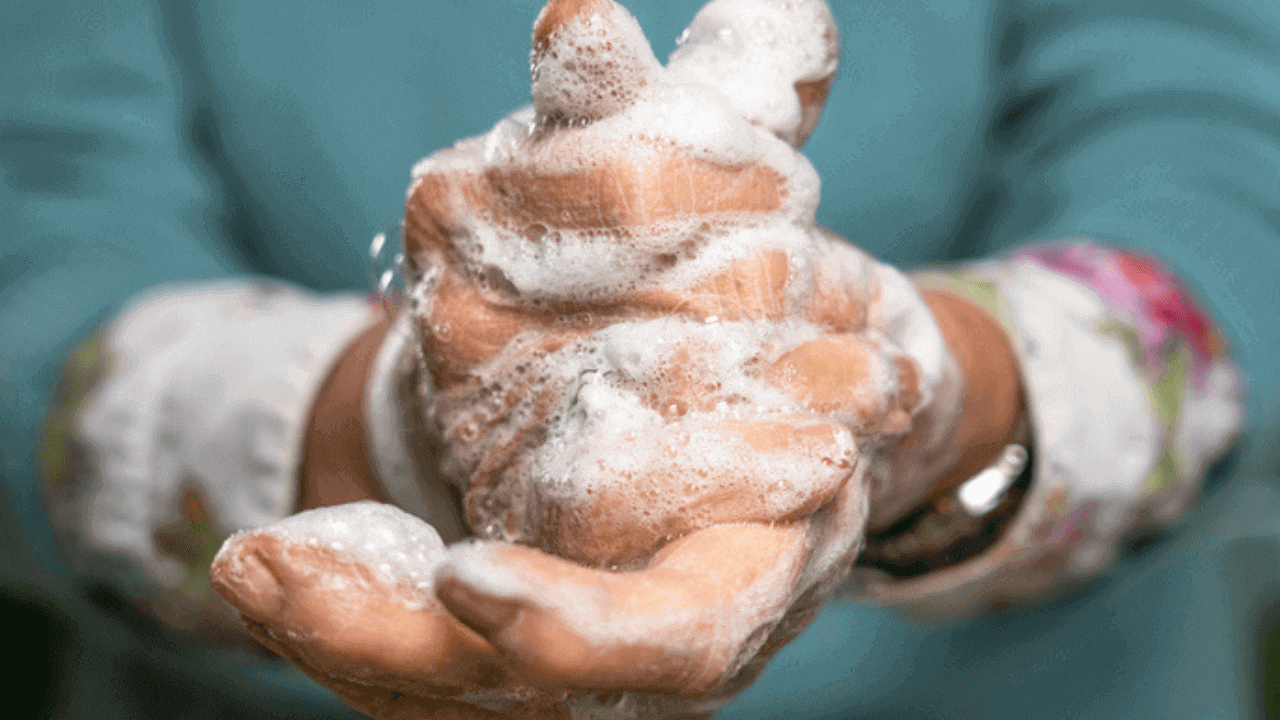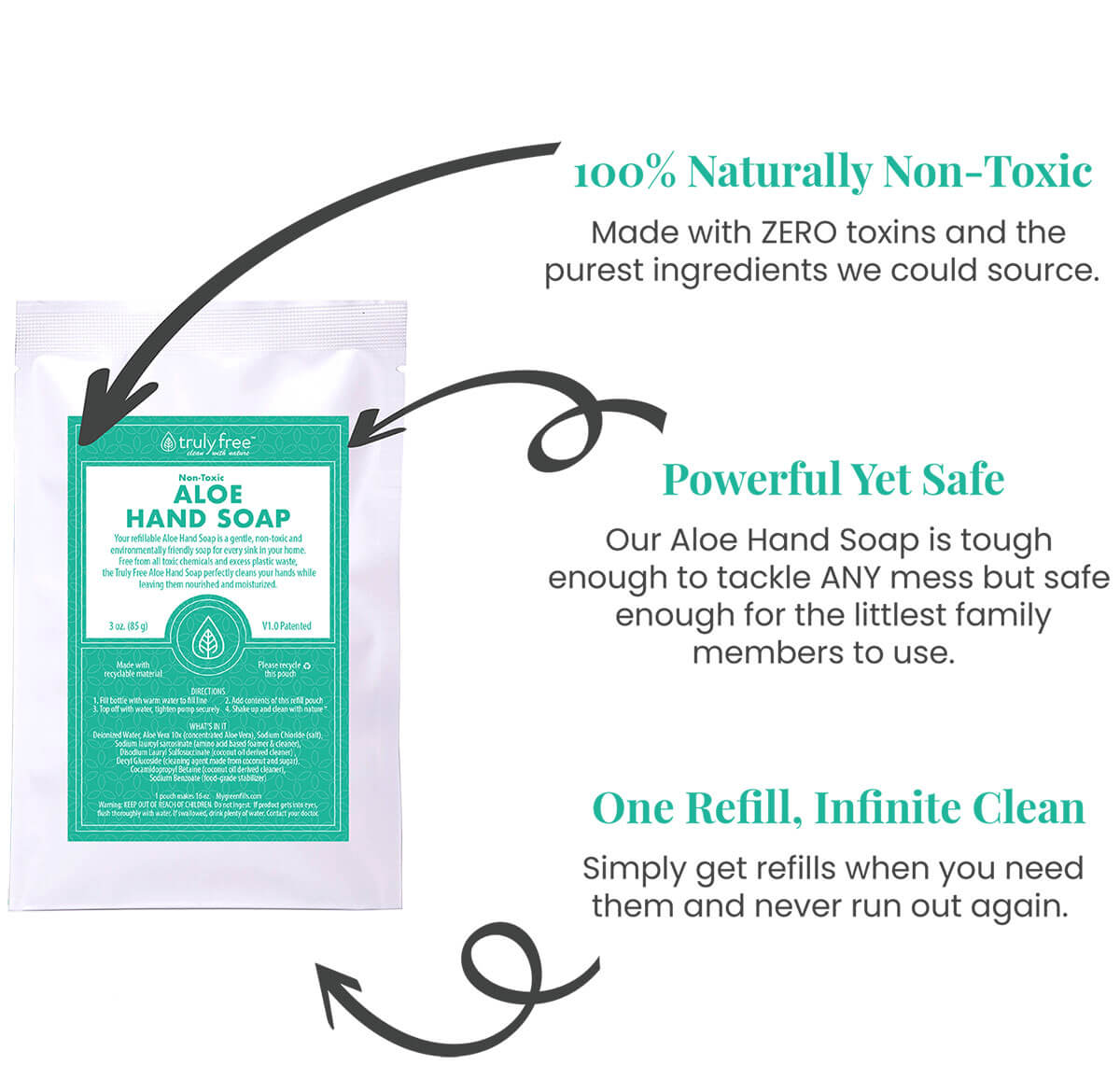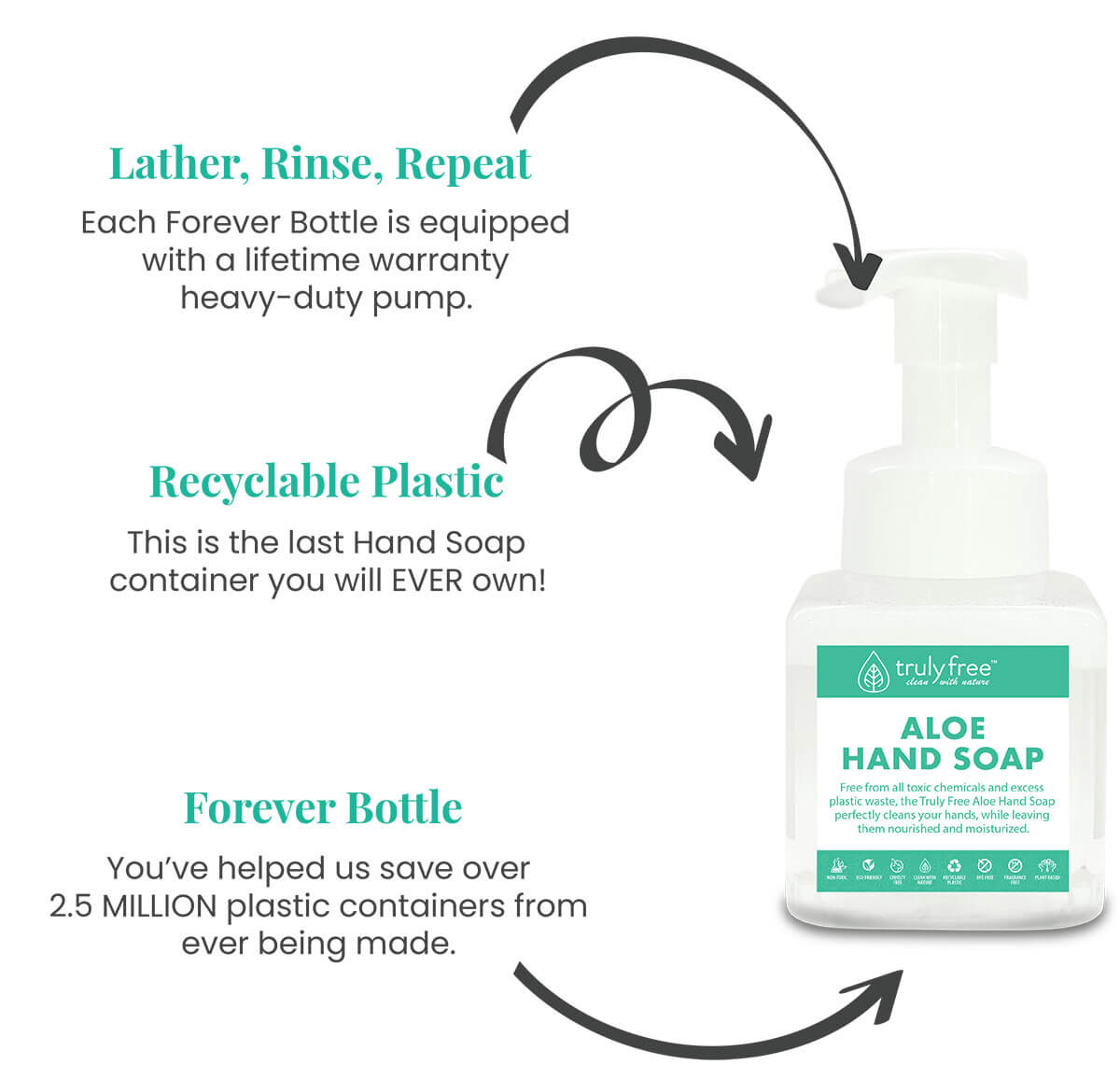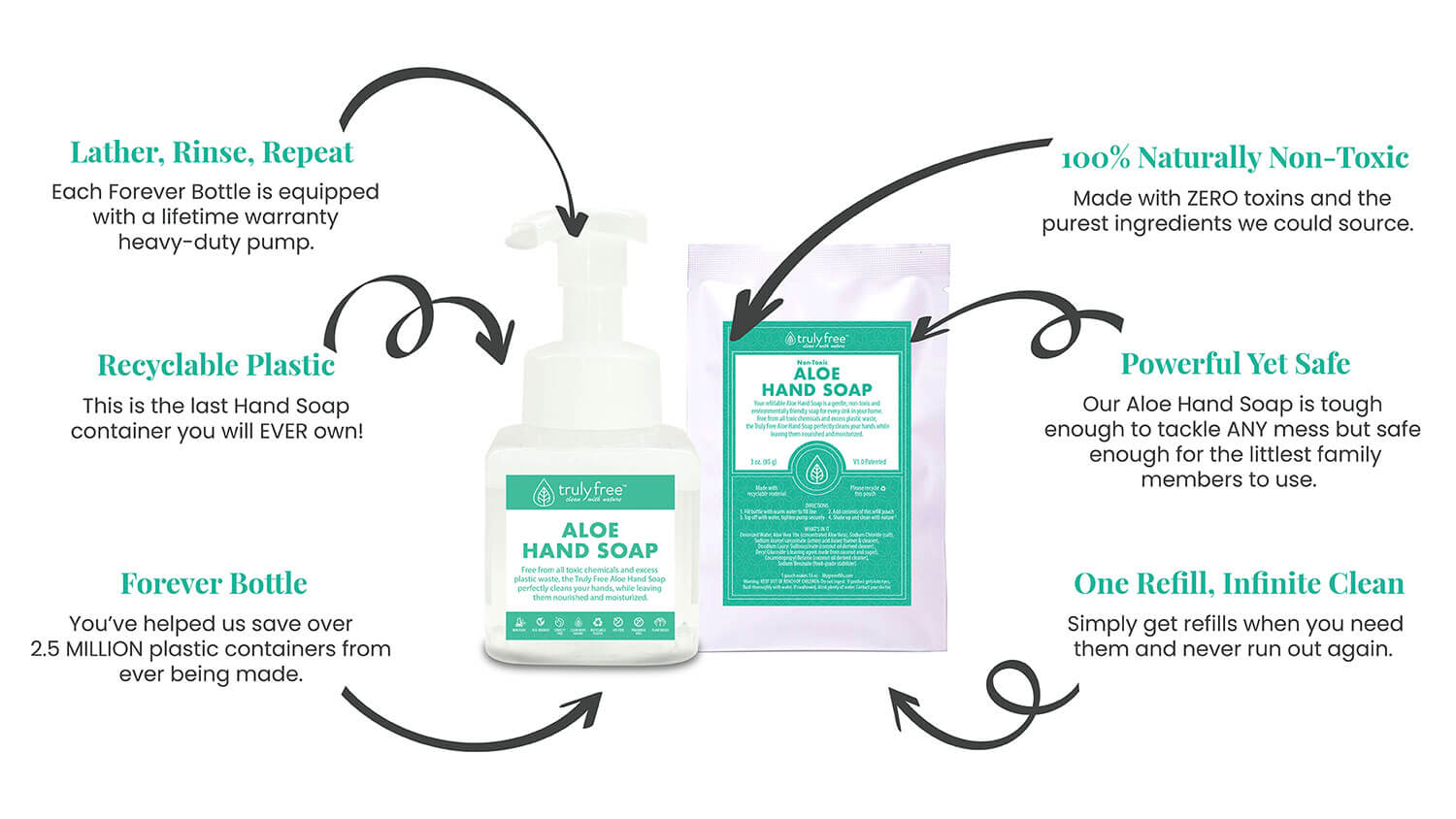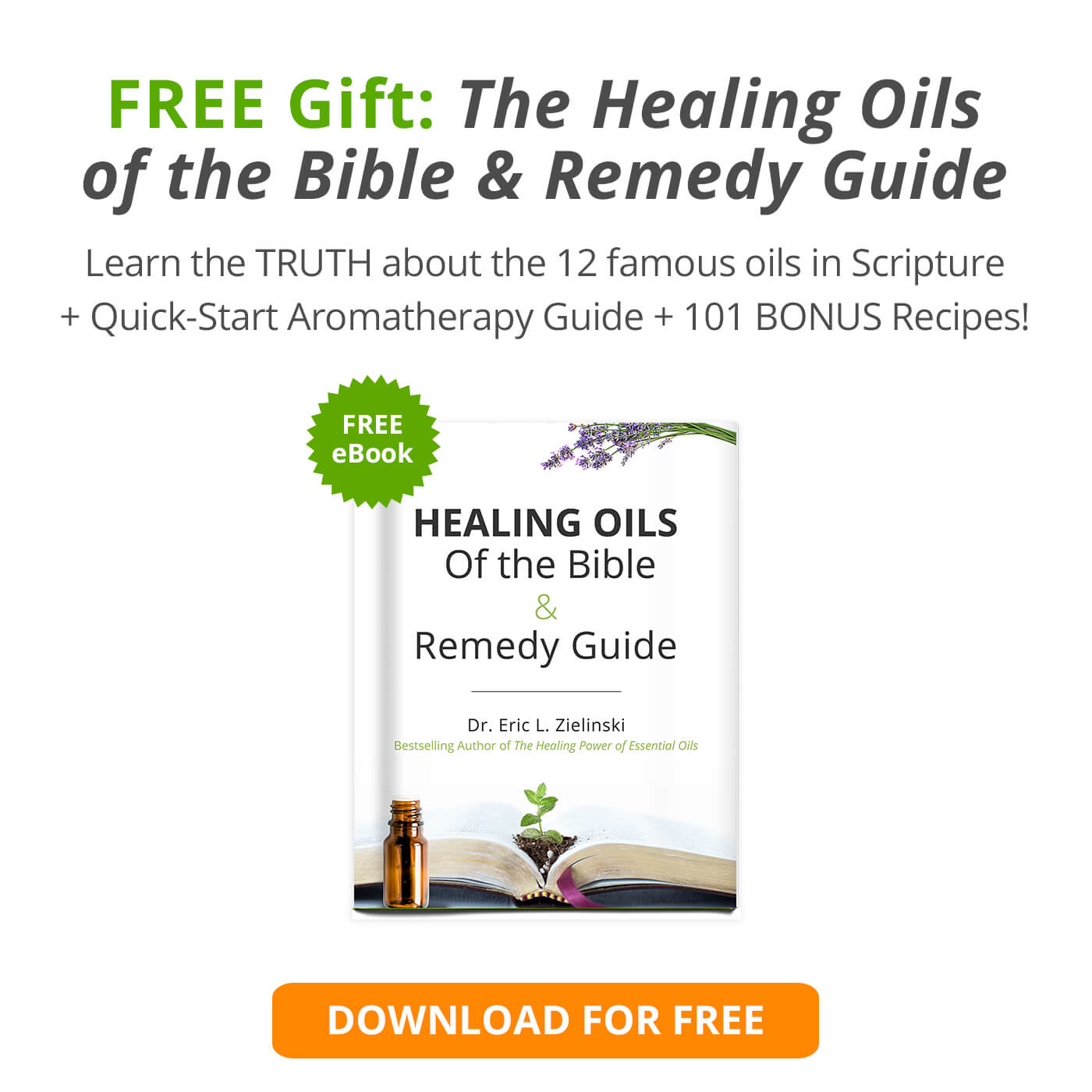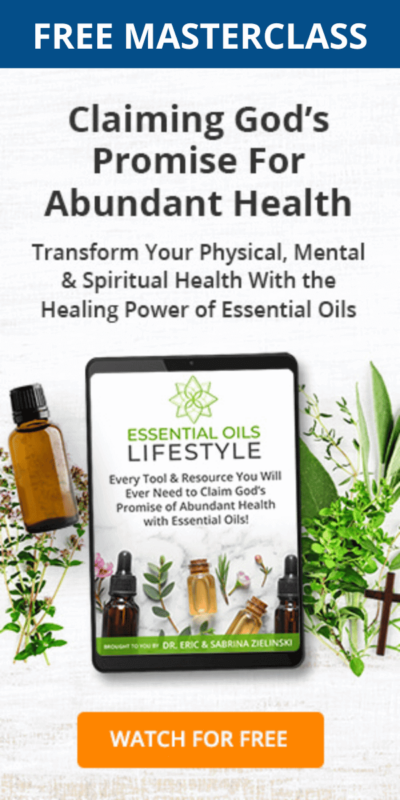When it comes to finding the best foaming hand soap you want to find something both non-toxic and eco-friendly. While I have learned to make my own liquid hand soap, and foaming hand soap in the past, with five kids now my time for DIYing is decreased. That’s when I turn to trusted companies like TrulyFree for moisturizing, safe, cleansing hand soap my family loves!
Table of Contents
Best Foaming Hand Soap
Given the current state of awareness about viruses, combined with the fact that we are heading into cold and flu season, it makes sense to be mindful about washing your hands on a regular basis. According to the Center for Disease Control (CDC), as much as 80 percent of all infectious diseases wind up being transmitted from person to person by touch. There is also indirect contact, i.e., touching an infected surface such as a doorknob. Washing your hands with soap and warm water has been shown to be highly effective in reducing bacteria and viruses regardless of whether it’s direct or indirect exposure.
When washing your hands multiple times per day it’s important to remember that proper sanitary hygiene means washing thoroughly. You need to not only wash the palm and backs of your hands, but you’ll also need to pay attention to the space between your fingers and thumbs, and to make sure you thoroughly wash your fingertips and your wrist. You want to make sure to take at least 20 seconds for a proper hand wash. That’s the amount of time it takes to sing Happy Birthday twice. The challenge is all that hand washing can leave you with dry, itchy red hands.
What’s In Your Handsoap?
As helpful as it is to wash your hands on a regular basis, what’s in what your washing with can be a real cause for concern. That’s because conventional hand soaps tend to be made with harsh chemicals such as fragrances, preservatives, and other toxins. These ingredients are harmful to both your skin and to your body. Even hand soaps labeled as “green” may still have chemicals and negative ingredients in them.
SPECIAL PRICE JUST FOR NATURAL LIVING FAMILY READERS!
Our Natural Living Family “group buy” will saves you up to 60% off as you protect your family from germs without toxic chemicals. Check out TrulyFree foaming hand soap HERE!
Although commercial soap producers may put a list of ingredients on their packaging, chances are you may not be reading the label. Unfortunately, we tend to shop in response to advertising slogans on the front of the package. Or you buy what you’ve always bought and simply don’t think about what’s in it. That means you’re potentially using a soap, expecting it to clean your hands, face, and body, but not realizing that you’re getting a huge toxic load at the same time.
Antibacterial soaps in particular can be harmful. These use chemicals that not only get rid of the negative bacteria on your hands, they destroy all the bacteria. Even the beneficial ones that you want to keep. One potential side effect of regularly using antibacterial soaps is that they can cause changes that may lead to bacterial mutation and antibiotic resistance. This applies not only to hand soap but to any antibacterial product such as body wash, shampoo, toothpaste, and other personal care products. That’s a pretty scary thought, to be using personal care products, which you think are protecting you from foreign bacteria, only for your soap or personal care items to cause a serious illness.
At this point, you’re probably making a commitment to yourself to read those labels. You need to know what you’re looking for though. Here are some of the most harmful ingredients you’re likely to find in your hand soap (and other cleaners as well):
- 1,4-dioxane – According to the United States Environmental Protection Agency (EPA) this ingredient is a probable human carcinogen, meaning it is likely to cause cancer. In laboratory studies, low levels of exposure were found to cause irritation to the eyes and the nose. Increased exposure was linked with the potential for liver and kidney issues up to and including developing tumors. Also a source of high environmental impact, 1,4-dioxane is frequently found in residential wastewater, has been shown to be persistent in groundwater, and is non-biodegradable.
- Parabens –Repeated exposure to this preservative ingredient has been shown to impact hormonal health and potentially cause cancer. In a laboratory setting pregnant rats who were exposed to parabens had male offspring with increased estrogen levels, damaged testicular structure, and sperm abnormalities. Parabens given to pregnant animals also resulted in offspring with learning and social interaction difficulties. Parabens are easily absorbed into the system, especially in infants and young children.
- Sodium Lauryl Sulfate (SLS) –This is a surfactant, or foaming ingredient, which is used to create suds. However, just because it’s creating suds does not mean that it’s good for you. Due to its cleansing and detergent properties, SLS is also added to a wide range of personal care products. It’s found not only in hand soap, but also in shampoo, toothpaste, bath oils, shaving cream, sunscreen, and more. This is in spite of its potential for irritating your eyes and your skin. As a detergent-type ingredient, it’s frequently used to help break up oil and grease. Unfortunately, often SLS can go too far in removing oils. It can actually reduce the necessary oils that your skin needs to prevent it from drying out. That may cause or exacerbate conditions like eczema.
The Environmental Impact
In addition to the environmental challenges created by the ingredients like 1,4-dioxane, there’s another component to hand soaps that you need to be aware of. All of those containers. Think about it, you purchase a small hand soap dispenser. Possibly 6-10 ounces. When you’re done with it you throw the container away and buy another one. Lather, wash, repeat. All the while you’re purchasing a large number of plastic bottles that you keep throwing away when you’re done with them.
Even if you purchase a larger size refill bottle, with the amount of hand washing you’re doing these days that can still add up to a lot of soap dispensers and bottles. Plastic containers can take, literally, hundreds of years to break down. And which pollute the environment while they are s-l-o-w-l-y decomposing.
Eco-Friendly AND Non-Toxic:As part of the Natural Living Family save 64% and enjoy non-toxic, foaming hand soap today!.
One way to help decrease your environmental footprint, aside from avoiding all of those environmentally unfriendly chemicals, is to choose a different kind of refill. Instead of a large plastic jug look for a non-toxic hand soap that comes with a refillable container and the refills are in a recyclable pouch. Because the pouches are meant to be recycled it means minimal packaging. In combination with just one hand soap bottle, it adds up to a reduced environmental impact.
Save Big with Our Group Special and let your family experience the best foaming hand soap we’ve found yet – eco-friendly and non-toxic!
Choosing a Safer Hand Soap
When looking for a hand soap that will get the job done, doesn’t contain toxins, and won’t harm the environment it can be hard to know what to look for. That’s because even many of the so-called “green” companies are still using ingredients that may be better than their conventional counterparts, but they’re still not all that great for you.
Obviously, you’ll need to start reading the label to understand what’s in your hand soap. You also need to make sure you’re choosing non-toxic ingredients that will help you cleanse your hands and protect your skin at the same time. The best option is to look for hand soaps that use saponified plant oils, not synthetics, surfactants, or toxic preservatives. Part of the challenge is that many of the better for you ingredients still use their Latin names. It can be really difficult to know that there really is a difference between Sodium Lauryl Sulfate and Sodium Lauroyl Sarcosinate. But there is. Here are a few of the ingredients you DO want to see in your hand soap with an explanation of what they do:
- Cocamidopropyl Betaine – a cleaner, made from coconut oil
- Decyl Glucoside – this cleaning agent is made from coconut and sugar
- Disodium Lauryl Sulfosuccinate – another cleaner derived from coconut oil
- Sodium Lauroyl Sarcosinate – an amino acid-based foamer and cleaner
What most ingredients all have in common is that they are made from coconut oil. Obviously, if you are allergic to coconut, products made with these kinds of ingredients are not going to be a good choice for you. However, if you or someone you love has a nut allergy this does not automatically rule out coconut-derived products. That’s because coconuts are not actually a nut. They are actually a type of fruit botanically referred to as a drupe. Coconut is a versatile and effective base ingredient for cleaning and, unlike other cleaners (such as Sodium Lauryl Sulfate) won’t strip your skin of beneficial oils.
To make sure you are getting the best, healthiest hand soap for you, be sure to learn about which ingredients are or are not good choices, think about the eco-friendly benefits of choosing better packaging, and remember to wash your hands regularly.
Learn more about TrulyFree and get your healthy, eco-friendly hand soap at Natural Living Family group special pricing!
References:
- 2020. Clu-In.Org. https://clu-in.org/download/contaminantfocus/dioxane/1,4-Dioxane_Fact_Sheet.pdf.
- “ATSDR – Public Health Statement: 1,4-Dioxane”. 2020.Atsdr.Cdc.Gov. https://www.atsdr.cdc.gov/phs/phs.asp?id=953&tid=199.
“Environmental Support | Flu & Pneumonia Interventions | Workplace Health Strategies By Condition | Workplace Health Promotion | CDC”.Cdc.Gov, 2020, https://www.cdc.gov/workplacehealthpromotion/health-strategies/flu-pneumonia/interventions/environmental-support.html. Accessed 7 Nov 2020. - Epa.Gov, 2020, https://www.epa.gov/sites/production/files/2014-03/documents/ffrro_factsheet_contaminant_14-dioxane_january2014_final.pdf. Accessed 7 Nov 2020.
Garden, Home, HowStuffWorks, Health, Care, Cleansing, and Tips. 2009. “Top 5 Allergens In Soaps That Cause Dermatitis”.Howstuffworks. https://health.howstuffworks.com/skin-care/cleansing/tips/5-allergens-in-soaps-cause-dermatitis1.htm. - Liu, Guoqiang et al. “Cytotoxicity Study Of Polyethylene Glycol Derivatives”. RSC Advances, vol 7, no. 30, 2017, pp. 18252-18259. Royal Society Of Chemistry (RSC), doi:10.1039/c7ra00861a. Accessed 5 Nov 2020.
- Lu, Ji et al. “Non-Antibiotic Antimicrobial Triclosan Induces Multiple Antibiotic Resistance Through Genetic Mutation”.Environment International, vol 118, 2018, pp. 257-265.Elsevier BV, doi:10.1016/j.envint.2018.06.004. Accessed 7 Nov 2020.
- Melin, Vanessa E. et al. “Exposure To Common Quaternary Ammonium Disinfectants Decreases Fertility In Mice”. Reproductive Toxicology, vol 50, 2014, pp. 163-170. Elsevier BV, doi:10.1016/j.reprotox.2014.07.071. Accessed 10 Nov 2020.
- Nowak, Karolina, Wioletta Ratajczak–Wrona, Maria Górska, and Ewa Jabłońska. 2018. “Parabens And Their Effects On The Endocrine System”.Molecular And Cellular Endocrinology474: 238-251. doi:10.1016/j.mce.2018.03.014.
- Parabens: The love-hate molecule – https://www.researchgate.net/profile/Gupta_P_D/publication/341238153_Parabens_The_love_-_hate_molecule/links/5ebb5de7458515626ca56454/Parabens-The-love-hate-molecule.pdf


